The Relationship between Concrete Strength and Classes of Resistance against Corrosion Induced by Carbonation: A Proposal for the Design of Extremely Durable Structures in Accordance with Eurocode 2
Abstract
1. Introduction
2. Materials and Methods
2.1. Carbonation Front, a Deterministic Point of View
2.2. Minimum Cover Required for Protection against Carbonation in prEN 1992
3. Results
3.1. Continuous Formulation of the Carbonation front Based on Eurocode 2
3.2. Case Studies
3.2.1. The Green Tunnel on the London–Birmingham High Speed Railway Line
3.2.2. Camino de Ronda Street Buildings (Granada, Spain)
4. Limitations of the Study
5. Conclusions
- The presented study proposes a new continuous formulation for the carbonation front.
- The formulation is based on the ‘square root of time’ expression given by the relevant literature and is in accordance with the minimum cover proposed by prEN 1992.
- The minimum cover required to protect against carbonation can be determined from the proposed expression, which is formulated as a function of the compressive strength of concrete.
- The proposed expression allows for the indicative strength classes against corrosion induced by carbonation proposed by prEN 1992 to be considered.
- The new expression is shown to be a useful tool for the design of extremely durable structures.
Author Contributions
Funding
Institutional Review Board Statement
Informed Consent Statement
Data Availability Statement
Conflicts of Interest
References
- Sánchez, J.; Torres, J.E.; Rebolledo, N. Brittle Behavior of Corroded Rebars. Hormigón Acero 2020, 1–7. [Google Scholar] [CrossRef]
- Williamson, S.J.; Clark, L.A. Effect of Corrosion and Load on Reinforcement Bond Strength. Struct. Eng. Int. 2002, 12, 117–122. [Google Scholar] [CrossRef]
- Val, D.V.; Stewart, M.G. Reliability Assessment of Ageing Reinforced Concrete Structures—Current Situation and Future Challenges. Struct. Eng. Int. 2009, 19, 211–219. [Google Scholar] [CrossRef]
- de Boer, A.; Gulikers, J. Effect of Reinforcement Geometry on the Probability of Corrosion Initiation in Reinforced Concrete Structures. Struct. Eng. Int. 2009, 19, 198–202. [Google Scholar] [CrossRef]
- Carbonell-Márquez, J.F.; Gil-Martín, L.M.; Fernández-Ruiz, M.A.; Hernández-Montes, E. Procedure for the Assessment of the Residual Capacity of Corroded B-Regions in RC Structures. Constr. Build. Mater. 2016, 121, 519–534. [Google Scholar] [CrossRef]
- Hernández-Montes, E.; Fernández-Ruiz, M.A.; Carbonell-Márquez, J.F.; Gil-Martín, L.M. Residual Capacity Assessment of Reinforced Concrete D-Regions Affected by Corrosion. Constr. Build. Mater. 2020, 263, 120228. [Google Scholar] [CrossRef]
- Tuutti, K. Corrosion of Steel in Concrete. Ph.D. Thesis, Swedish Cement and Concrete Research Institute, Stockholm, Sweden, 1982. [Google Scholar]
- Possan, E.; Dal Molin, D.C.C.; Andrade, J.J.O. A Conceptual Framework for Service Life Prediction of Reinforced Concrete Structures. J. Build. Pathol. Rehabil. 2018, 3, 2. [Google Scholar] [CrossRef]
- Andrade, C. Future Trends in Research on Reinforcement Corrosion. In Corrosion of Steel in Concrete Structures; Poursaee, A., Ed.; Woodhead Publishing: Oxford, UK, 2016; pp. 269–288. ISBN 978-1-78242-381-2. [Google Scholar]
- Kouassi, F.A.; Dauxois, J.-Y.; Duprat, F.; De Larrard, T.; Deby, F. Engineering Statistical Models for Carbonation Depth. Eur. J. Environ. Civ. Eng. 2022, 27, 215–238. [Google Scholar] [CrossRef]
- Isaksson, R.; Rosvall, M.; Espuny, M.; Nunhes, T.V.; de Oliveira, O.J. How Is Building Sustainability Understood?—A Study of Research Papers and Sustainability Reports. Sustainability 2022, 14, 12430. [Google Scholar] [CrossRef]
- Andrade, M.C.; Castro-Borges, P.; Pazini, E. Detection of Corrosion Risk besides Patch Repairs. Hormigón Acero 2021, 72, 41–58. [Google Scholar]
- Chinchón, S.; Sánchez, J.; Ortega, L.M.; García, J.; Rebolledo, N.; Torres, J.E.; Perilbáñez, J. Nueva Metodología Para La Delimitación de Las Zonas a Reparar de Un Hormigón Afectado Por Corrosión. Hormigón Acero 2022, 73, 51–57. [Google Scholar] [CrossRef]
- Ali, M.E.; Hasan, M.F.; Siddiqa, S.; Molla, M.M.; Nasrin Akhter, M. FVM-RANS Modeling of Air Pollutants Dispersion and Traffic Emission in Dhaka City on a Suburb Scale. Sustainability 2023, 15, 673. [Google Scholar] [CrossRef]
- Silva, A.; Neves, R.; De Brito, J. Statistical Modelling of Carbonation in Reinforced Concrete. Cem. Concr. Compos. 2014, 50, 73–81. [Google Scholar] [CrossRef]
- Andrade, C.; Alonso, C.; Gonzalez, C. Remaining Service Life of Corroding Structures; International Association for Bridge and Structural Engineering: Zurich, Switzerland, 2020. [Google Scholar]
- Keršner, Z.; Teplý, B.; Novak, D. Uncertainty in Service Life Prediction Based on Carbonation of Concrete. In Durability of Building Materials and Components 7; Sjostrom, C., Ed.; Routledge: London, UK, 1996; pp. 1–8. ISBN 9781315025025. [Google Scholar]
- Saetta, A.V.; Vitaliani, R.V. Experimental Investigation and Numerical Modeling of Carbonation Process in Reinforced Concrete Structures Part I: Theoretical Formulation. Cem. Concr. Res. 2004, 34, 571–579. [Google Scholar] [CrossRef]
- Papadakis, V.G.; Vayenas, C.G.; Fardis, M.N. Experimental Investigation and Mathematical Modeling of the Concrete Carbonation Problem. Chem. Eng. Sci. 1991, 46, 1333–1338. [Google Scholar] [CrossRef]
- Papadakis, V.G.; Vayenas, C.G.; Fardis, M.N. Fundamental Modeling and Experimental Investigation of Concrete Carbonation. ACI Mater. J. 1991, 88, 363–373. [Google Scholar] [CrossRef]
- Hills, T.P.; Gordon, F.; Florin, N.H.; Fennell, P.S. Statistical Analysis of the Carbonation Rate of Concrete. Cem. Concr. Res. 2015, 72, 98–107. [Google Scholar] [CrossRef]
- Saetta, A.V.; Vitaliani, R.V. Experimental Investigation and Numerical Modeling of Carbonation Process in Reinforced Concrete Structures: Part II. Practical Applications. Cem. Concr. Res. 2005, 35, 958–967. [Google Scholar] [CrossRef]
- Endale, S.A.; Taffese, W.Z.; Vo, D.H.; Yehualaw, M.D. Rice Husk Ash in Concrete. Sustainability 2023, 15, 137. [Google Scholar] [CrossRef]
- Marchand, J.; Samson, E. Predicting the Service-Life of Concrete Structures—Limitations of Simplified Models. Cem. Concr. Compos. 2009, 31, 515–521. [Google Scholar] [CrossRef]
- Chen, Y.; Liu, P.; Yu, Z. Effects of Environmental Factors on Concrete Carbonation Depth and Compressive Strength. Materials 2018, 11, 2167. [Google Scholar] [CrossRef] [PubMed]
- Ekolu, S.O. Model for Practical Prediction of Natural Carbonation in Reinforced Concrete: Part 1-Formulation. Cem. Concr. Compos. 2018, 86, 40–56. [Google Scholar] [CrossRef]
- Zhu, J.; Zhang, R.; Zhang, Y.; He, F. The Fractal Characteristics of Pore Size Distribution in Cement-Based Materials and Its Effect on Gas Permeability. Sci. Rep. 2019, 9, 17191. [Google Scholar] [CrossRef]
- Monteiro, I.; Branco, F.A.; De Brito, J.; Neves, R. Statistical Analysis of the Carbonation Coefficient in Open Air Concrete Structures. Constr. Build. Mater. 2012, 29, 263–269. [Google Scholar] [CrossRef]
- You, X.; Hu, X.; He, P.; Liu, J.; Shi, C. A Review on the Modelling of Carbonation of Hardened and Fresh Cement-Based Materials. Cem. Concr. Compos. 2022, 125, 104315. [Google Scholar] [CrossRef]
- Bakker, R. Corrosion of Steel in Concrete, “Initiation Period”; Schiessl, P., Ed.; RILEM; Chapman & Hall: London, UK, 1988. [Google Scholar]
- Ghanooni-Bagha, M.; YekeFallah, M.R.; Shayanfar, M.A. Durability of RC Structures against Carbonation-Induced Corrosion under the Impact of Climate Change. KSCE J. Civ. Eng. 2020, 24, 131–142. [Google Scholar] [CrossRef]
- Gonçalves, A.F.; Ferreira, M.J.E.; Ribeiro, A.B. The New Lnec Specifications on Reinforced Concrete Durability. In Proceedings of the International RILEM Workshop on Integrated Service Life Modelling of Concrete Structures, Guimarães, Portugal, 5–6 November 2007; pp. 131–140. [Google Scholar]
- UNE-EN 1992-1-1; Eurocode 2: Design of Concrete Structures—Part 1–1: General Rules and Rules for Buildings. European Committee for Standardization: Brussels, Belgium, 2013.
- prEN 1992-1-1; Eurocode 2: Design of Concrete Structures—Part 1–1: General Rules and Rules for Buildings, Bridges and Civil Engineering Structures. European Committee for Standardization: Brussels, Belgium, 2022.
- MITMA. Código Estructural. Volumenes 1 y 2; MITMA: Madrid, Spain, 2021. [Google Scholar]
- fib-International Federation for Structural Concrete. Bulletin 34: Model Code for Service Life Design; fib: Lausanne, Switzerland, 2006. [Google Scholar]
- Fonseca, E.T.; Vellasco, P.C.G.D.S.; Vellasco, M.M.B.R.; de Andrade, S.A.L. A Neuro-Fuzzy Evaluation of Steel Beams Patch Load Behaviour. Adv. Eng. Softw. 2008, 39, 558–572. [Google Scholar] [CrossRef]
- Sanchez, M.; Alonso, M.C. Repassivation of Steel Rebars after an Electrochemical Chlorides Removal Treatment by Simultaneous Application of Calcium Nitrite. In Concrete under Severe Conditions: Environment and Loading, Proceedings of the 6th International Conference on Concrete under Severe Conditions, CONSEC’10, Yucatán, Mexico, 7–9 June 2010; CRC Press/Balkema: Leiden, The Netherlands, 2010; Volume 2, pp. 1109–1114. [Google Scholar]
- Alonso, M.C.; García Calvo, J.L.; Hidalgo, A.; Fernández Luco, L. 10—Development and Application of Low-PH Concretes for Structural Purposes in Geological Repository Systems. In Geological Repository Systems for Safe Disposal of Spent Nuclear Fuels and Radioactive Waste; Ahn, J., Apted, M.J., Eds.; Woodhead Publishing Series in Energy; Woodhead Publishing: Sawston, UK, 2010; pp. 286–322. ISBN 978-1-84569-542-2. [Google Scholar]
- Andrade, C. Corrosion Of Steel Reinforcement. WIT Trans. State-of-the-Art Sci. Eng. 2007, 28, 185–216. [Google Scholar] [CrossRef]
- UNE EN 206-1:2008; Concrete —Part 1: Specification, Performance, Production and Conformity. Asociación Española de Normalización y Certificación (AENOR): Madrid, Spain, 2008.
- Hernández, L.; Gil-Martín, L.M. A Comparison of the Most Important Properties of Structural Concrete: European Standards versus American Standards. Eur. J. Environ. Civ. Eng. 2022, 1–14. [Google Scholar] [CrossRef]

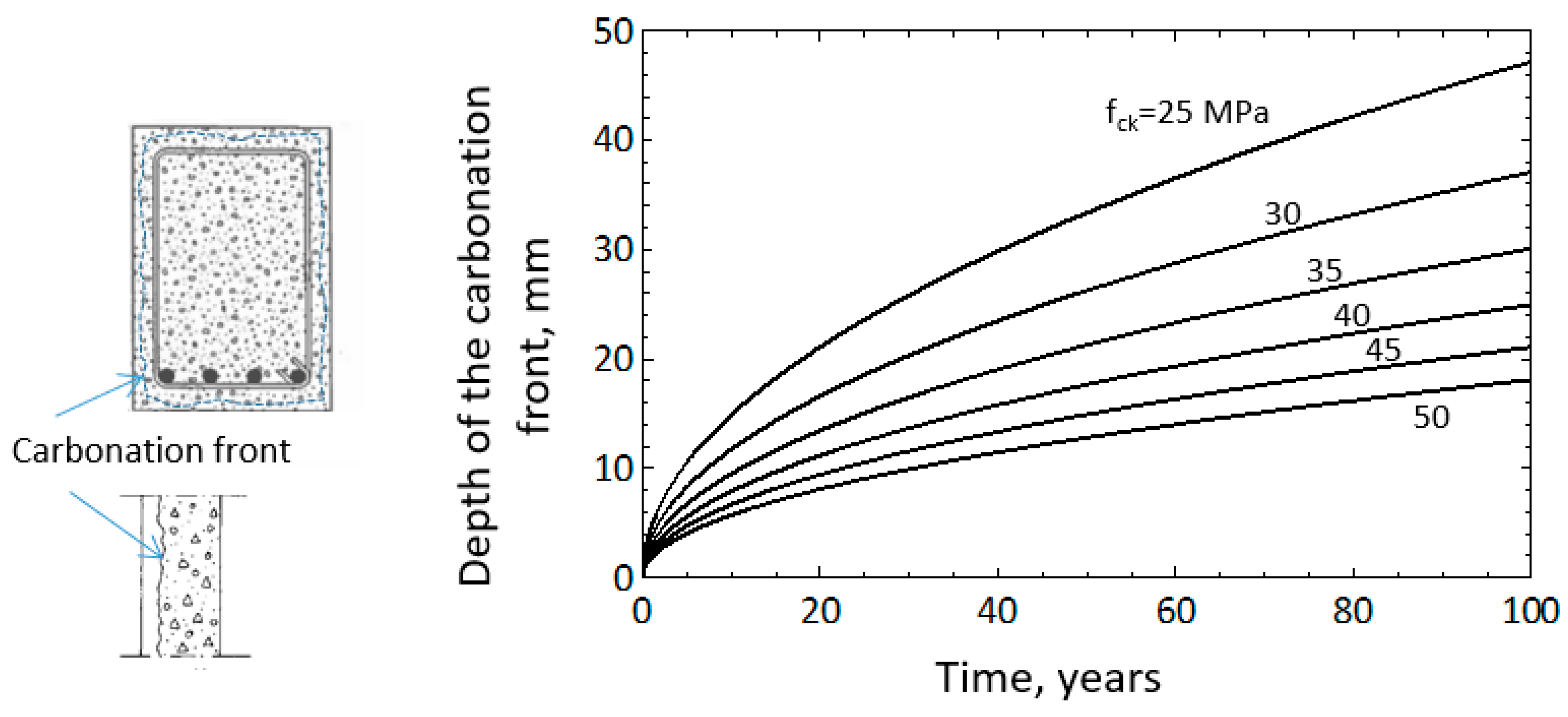
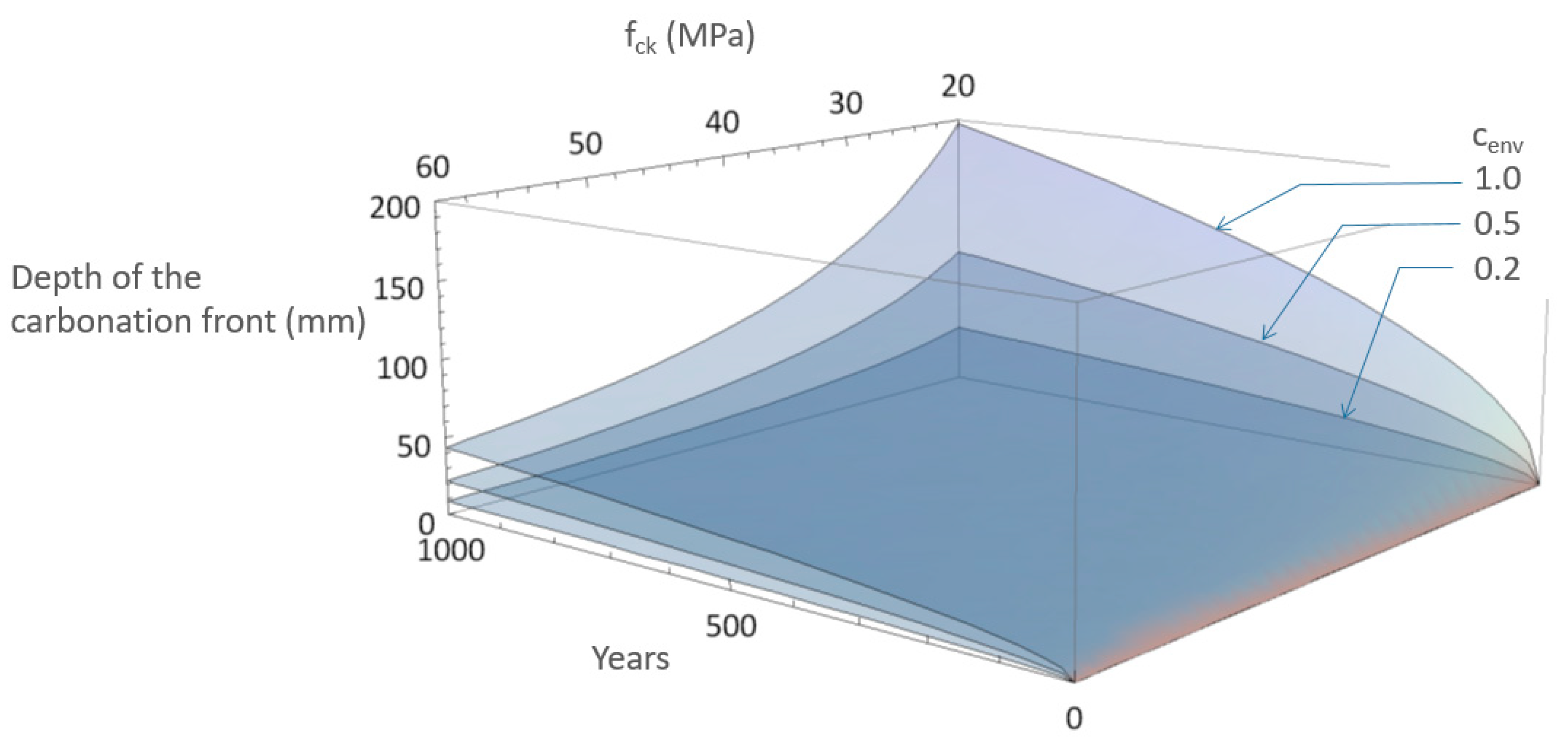
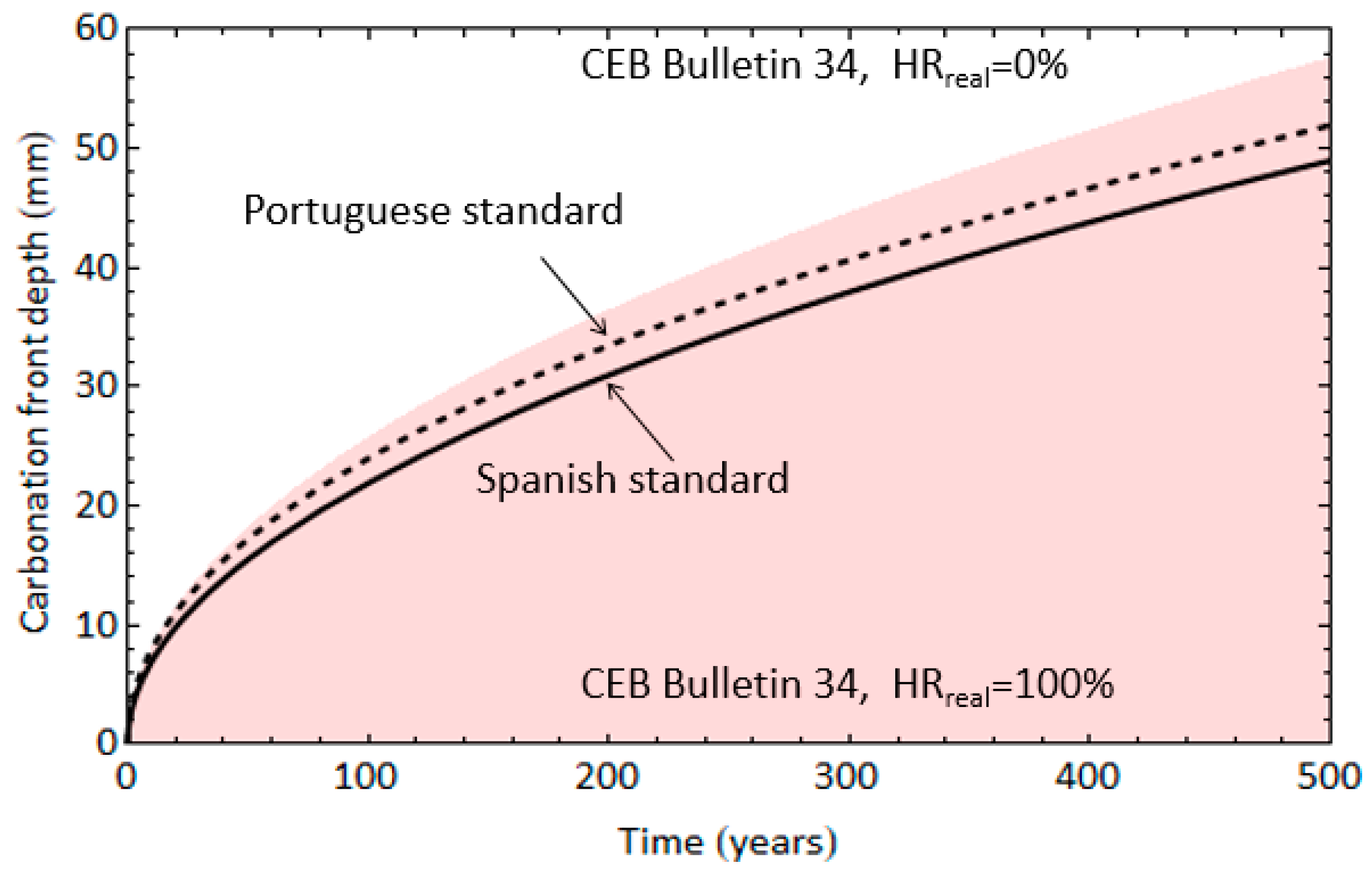
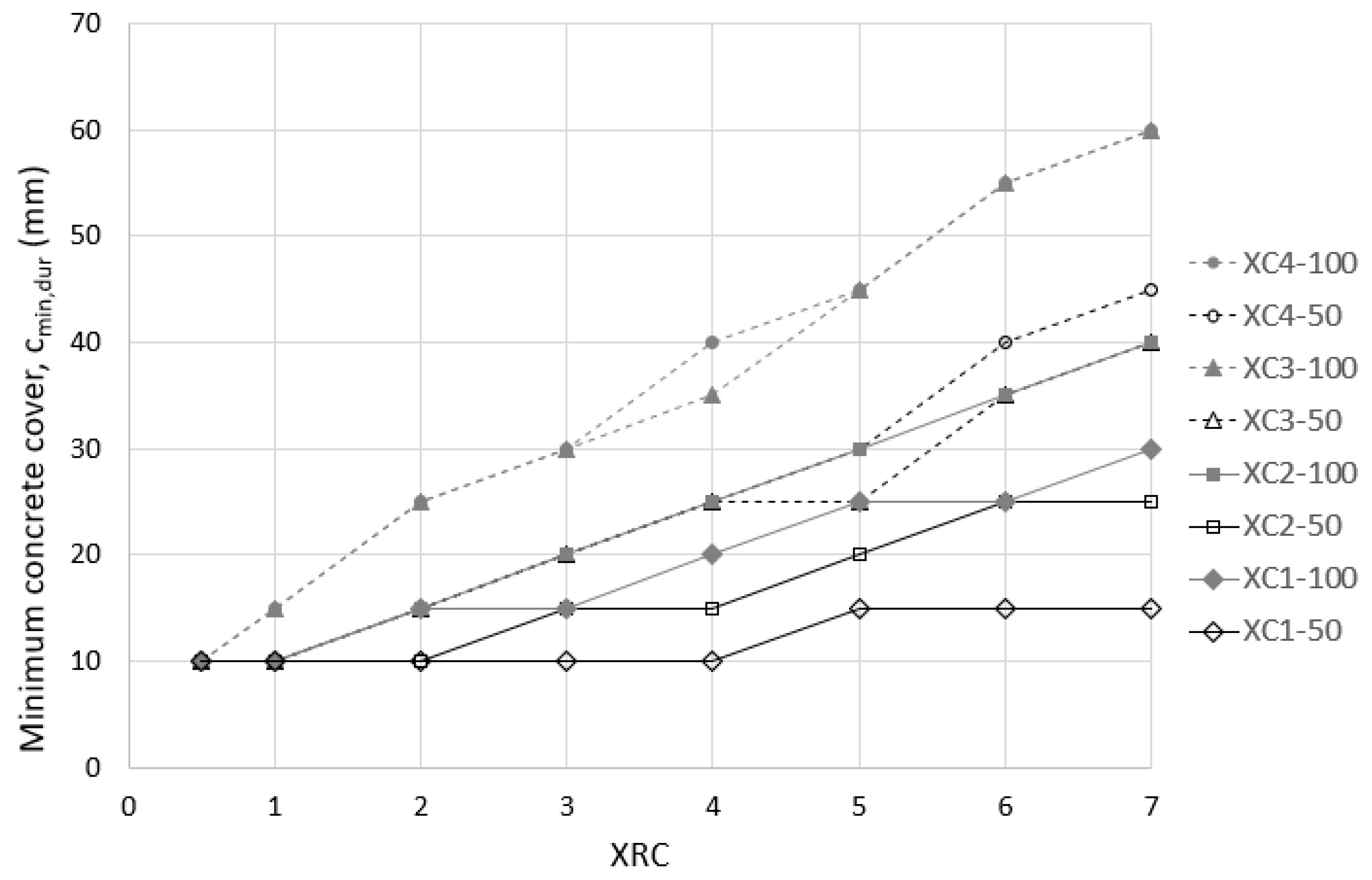
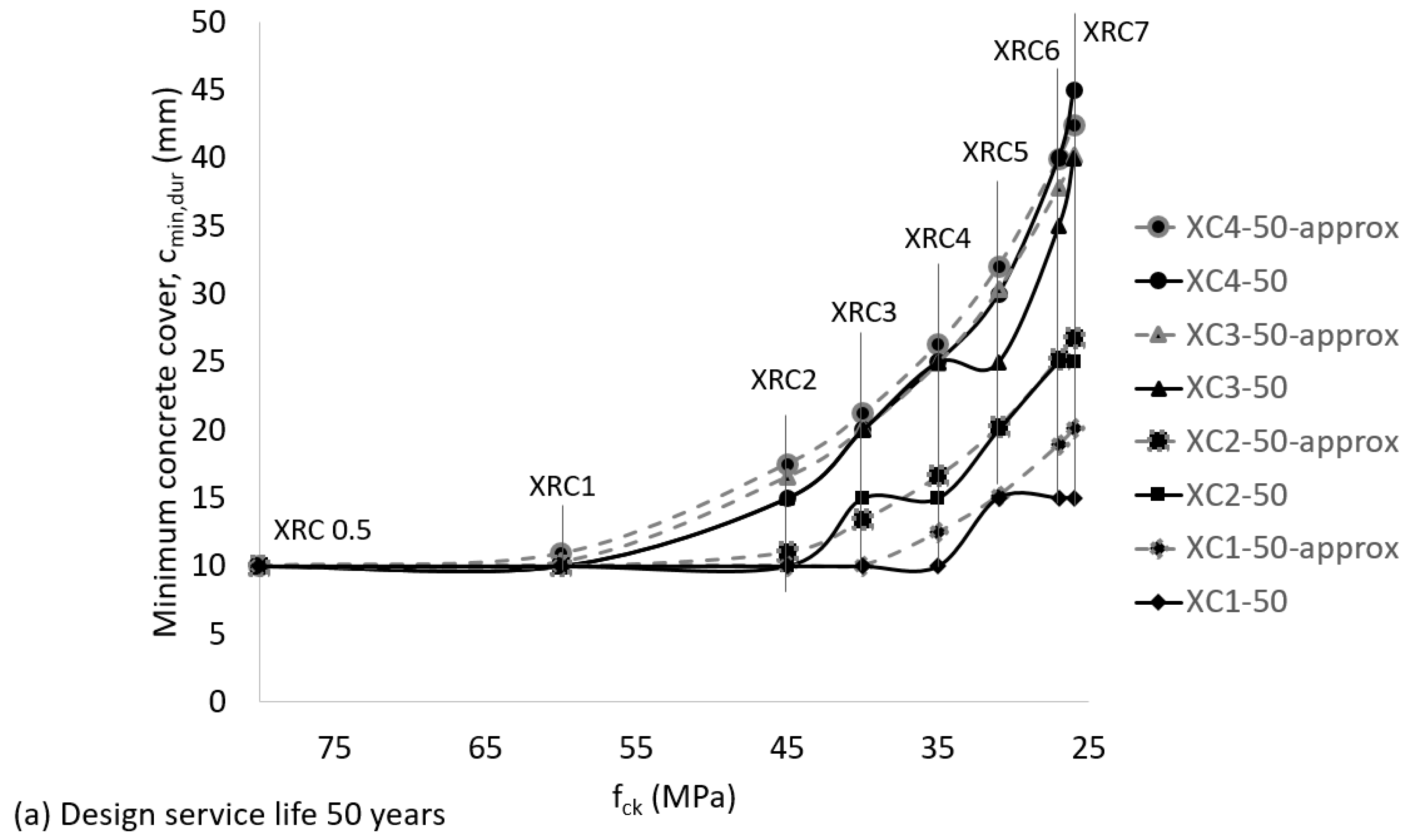


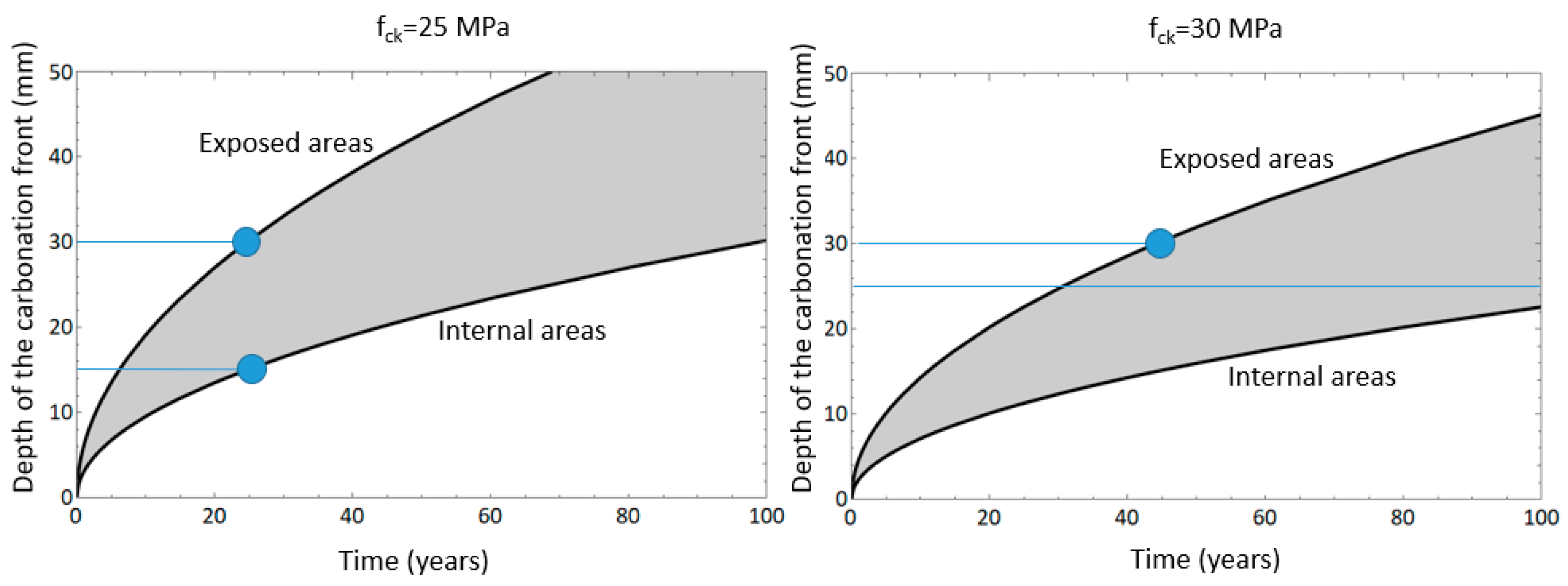
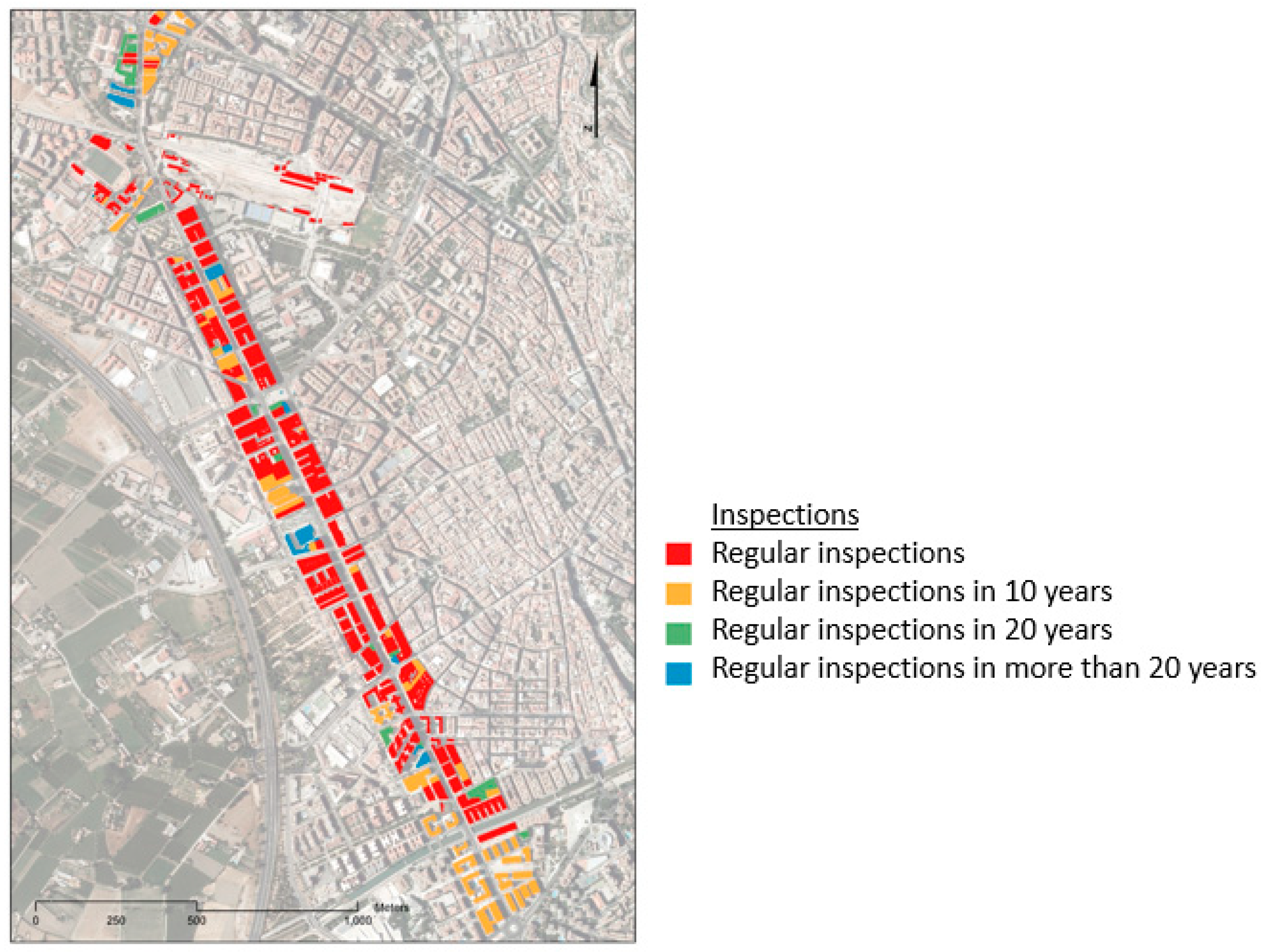
| Environment | cenv |
|---|---|
| Sheltered from the rain | 1.0 |
| Exposed to rain | 0.5 |
| Buried elements, above the water table | 0.3 |
| Buried elements, below the water table | 0.2 |
| Binder | a | b |
|---|---|---|
| Portland cement | 1800 | −1.7 |
| Portland cement +28% fly ash | 360 | −1.2 |
| Portland cement + 9% silica fume | 400 | −1.2 |
| Adjusted Exposure Classes for Carbonation | XC1 | XC2 | XC3 | XC4 |
|---|---|---|---|---|
| 0.45 | 0.60 | 0.90 | 0.95 |
| Type of Binder | Portland | Portland + 28% Fly Ash | Portland + 9% Silica Fume | ||||
|---|---|---|---|---|---|---|---|
| Entrained Air | >4.5% | <4.5% | >4.5% | <4.5% | >4.5% | <4.5% | |
| ERC in prEN 1992 [34] | XRC 0.5 | 63 | 80 | 94 | 128 | 103 | 139 |
| XRC 1 | 49 | 60 | 66 | 90 | 73 | 98 | |
| XRC 2 | 36 | 45 | 44 | 59 | 48 | 65 | |
| XRC 3 | 32 | 40 | 36 | 49 | 39 | 54 | |
| XRC 4 | 28 | 35 | 30 | 41 | 33 | 45 | |
| XRC 5 | 25 | 31 | 26 | 35 | 28 | 38 | |
| XRC 6 | 22 | 27 | 21 | 29 | 23 | 32 | |
| XRC 7 | 21 | 26 | 20 | 27 | 21 | 29 | |
| Exposure Class | XC1 | XC2 | XC3/XC4 |
|---|---|---|---|
| Strength class | ≥C20/25 | ≥C25/30 | ≥C30/37 |
| Element | Precast/Cast In Situ | Nominal Cover * | |
|---|---|---|---|
| Inner Face | Outer Face | ||
| Arch, Arch wall, Side Wall, Footing | Precast (C50/60) | 45 mm | 55 mm |
| Central Wall | Precast (C50/60) | 45 mm | 45 mm |
| Invert/Base Slab | Cast-in situ (C50/60) | 60 mm | 70 mm |
Disclaimer/Publisher’s Note: The statements, opinions and data contained in all publications are solely those of the individual author(s) and contributor(s) and not of MDPI and/or the editor(s). MDPI and/or the editor(s) disclaim responsibility for any injury to people or property resulting from any ideas, methods, instructions or products referred to in the content. |
© 2023 by the authors. Licensee MDPI, Basel, Switzerland. This article is an open access article distributed under the terms and conditions of the Creative Commons Attribution (CC BY) license (https://creativecommons.org/licenses/by/4.0/).
Share and Cite
Gil-Martín, L.M.; Hdz-Gil, L.; Molero, E.; Hernández-Montes, E. The Relationship between Concrete Strength and Classes of Resistance against Corrosion Induced by Carbonation: A Proposal for the Design of Extremely Durable Structures in Accordance with Eurocode 2. Sustainability 2023, 15, 7976. https://doi.org/10.3390/su15107976
Gil-Martín LM, Hdz-Gil L, Molero E, Hernández-Montes E. The Relationship between Concrete Strength and Classes of Resistance against Corrosion Induced by Carbonation: A Proposal for the Design of Extremely Durable Structures in Accordance with Eurocode 2. Sustainability. 2023; 15(10):7976. https://doi.org/10.3390/su15107976
Chicago/Turabian StyleGil-Martín, Luisa María, Luisa Hdz-Gil, Emilio Molero, and Enrique Hernández-Montes. 2023. "The Relationship between Concrete Strength and Classes of Resistance against Corrosion Induced by Carbonation: A Proposal for the Design of Extremely Durable Structures in Accordance with Eurocode 2" Sustainability 15, no. 10: 7976. https://doi.org/10.3390/su15107976
APA StyleGil-Martín, L. M., Hdz-Gil, L., Molero, E., & Hernández-Montes, E. (2023). The Relationship between Concrete Strength and Classes of Resistance against Corrosion Induced by Carbonation: A Proposal for the Design of Extremely Durable Structures in Accordance with Eurocode 2. Sustainability, 15(10), 7976. https://doi.org/10.3390/su15107976








